

Super Earths and Planetary Formation Recreated Using Laser Compression and Crystals. Researchers at the Lawrence Livermore National Laboratory (LLNL), Bayreuth University (Germany), LLNL and University of California, Berkeley were able to recreate the pressure and melting temperature of materials of a super-Earth planet at the core-mantle boundary.
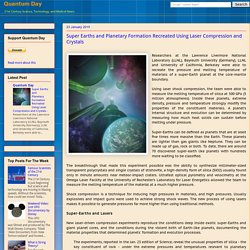
Using laser shock compression, the team were able to measure the melting temperature of silica at 500 GPa (5 million atmospheres). Inside these planets, extreme density, pressure and temperature strongly modify the properties of the constituent materials. A planet's internal structure and evolution can be determined by measuring how much heat solids can sustain before melting under pressure. Super-Earths can be defined as planets that are at least five times more massive than the Earth. These planets are lighter than gas giants like Neptune. Shock compression is a technique for inducing high pressures in materials, and high pressures. Two New Habitable Planets Found By NASA Kepler Mission. Eight new Earth-like planets have been found orbiting stars at a distance where water can exist on the surface.
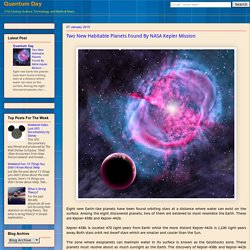
Among the eight discovered planets, two of them are believed to most resemble the Earth. These are Kepler-438b and Kepler-442b. Kepler-438b is located 470 light-years from Earth while the more distant Kepler-442b is 1,100 light-years away. Both stars orbit red dwarf stars which are smaller and cooler than the Sun. Evidence of Planetary Collision With Ancient Earth Found In Mantle. Scientists have found evidence of material that shows Earth may have collided with another object billions of years ago.
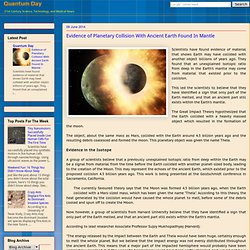
They found that an unexplained isotopic ratio from deep in the Earth's mantle may come from material that existed prior to the collision. Quantum Day. Planet Found Orbiting Rare Solar Twin In Open Star Cluster Messier 67. Using ESO's High Accuracy Radial Velocity Planet Searcher (HARPS), astronomers have discovered an exoplanet that is remarkable in two aspects; it is orbiting a rare solar twin and that it is found in an open star cluster.
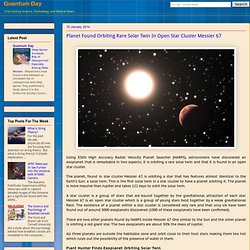
The planet, found in star cluster Messier 67, is orbiting a star that has features almost identical to the Earth's Sun; a solar twin. This is the first solar twin in a star cluster to have a planet orbiting it. The planet is more massive than Jupiter and takes 122 days to orbit the solar twin. Hubble Telescope Discover Clouds While Monitoring Atmospheric Weather on Distant Planet GJ1214b. The Hubble Telescope discovered evidence of high altitude clouds covering super-Earth exoplanet, GJ1214b.
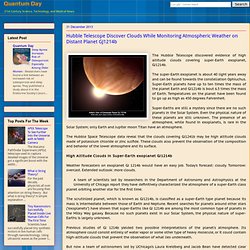
The super-Earth exoplanet is about 40 light years away and can be found towards the constellation Ophiuchus. Super-Earth planets have up to ten times the mass of the planet Earth and GJ1214b is bout 6.5 times the mass of Earth. Temperatures on the planet have been found to go up as high as 450 degrees Fahrenheit. Exoplanet HD 189733b Determined to be Color Blue Like the Earth. Lightest Exoplanet, HD95086b, Discovered by VLT 300 Light Years Away. The Very Large Telescope (VLT) of the ESO has directly imaged an exoplanet that is about four to five times the mass of Jupiter.
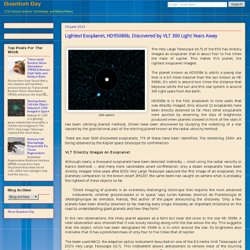
This makes this planet, the lightest exoplanet imaged. The planet, known as HD95086 b, orbits a young star that is a bit more massive than the sun known as HD 95086. It's orbit is around two times the distance that Neptune orbits the sun and this star system is around 300 light years from the Earth. HD95086 b is the first exoplanet in nine years that was directly imaged. Only around 12 exoplanets have been directly observed so far. There are over 3000 discovered exoplanets, 779 of these have been identified. Although nearly a thousand exoplanets have been detected indirectly — most using the radial velocity or transit methods — and many more candidates await confirmation, only a dozen exoplanets have been directly imaged. Study Shows Water On The Moon Came From Same Source As That of the Earth. A study on moon rocks and samples from the Apollo mission show that water on the moon came from the same source as that of water found on Earth.
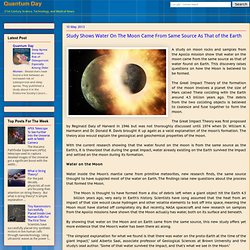
This discovery raises questions on how the Moon is believed to be formed. The Great Impact Theory of the formation of the moon involves a planet the size of Mars called Theia colliding with the Earth around 4.5 billion years ago. The debris from the two colliding objects is believed to coalesce and fuse together to form the moon. The Great Impact Theory was first proposed by Reginald Daly of Harvard in 1946 but was not thoroughly discussed until 1974 when Dr.
William K. Two Planets Within Habitable Zone Discovered Orbiting Kepler 62. Researchers have found two planets the size of the Earth within the habitable zone of its star, Kepler 62.
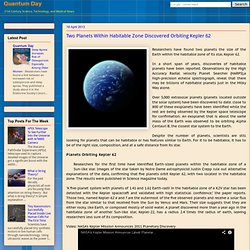
In a short span of years, discoveries of habitable planets have been reported. Observations by the High Accuracy Radial velocity Planet Searcher (HARPS),a high-precision echelle spectrograph, reveal that there may be billions of habitable planets just in the Milky Way alone. Over 3,000 extrasolar planets (planets located outside the solar system) have been discovered to date. close to 800 of these exoplanets have been identified while the rest are being observed by the Kepler space telescope for confirmation. Giant Planet Forming Within Ring of Star HD 100546 Discovered.
Planet Forming In Gas Cloud Near Star HD 100546 Discovered. The European Southern Observatory's VLT (Very Large Telescope) has discovered what is likely a forming planet within a thick disc of gas and dust.

This is the first time such a discovery has been made. Up until now, scientists have not directly observed or have discovered a planet that is in the process of forming. This discovery, when confirmed, may greatly advance planet formation theories and test current theories against the observation. In 1995, a planet orbiting a sun-like star outside of the Solar System was discovered. Soon after, several hundred exoplanets and planetary systems outside of the Solar System has been found. Planet Forming Disc of Gas And Dust Around Star HD 142527 Observed. The European Southern Observatory's ALMA space telescope has directly observed for the first time a disc of cosmic dust and gas around a young star, HD 142527.
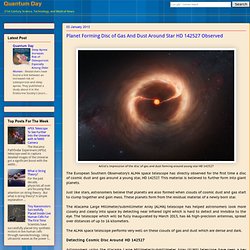
This material is believed to further form into giant planets. Just like stars, astronomers believe that planets are also formed when clouds of cosmic dust and gas start to clump together and gain mass. These planets form from the residual material of a newly born star. The Atacama Large Millimeter/submillimeter Array (ALMA) telescope has helped astronomers look more closely and clearly into space by detecting near infrared light which is hard to detect and invisible to the eye. The telescope which will be fully inaugurated by March 2013, has 66 high-precision antennas, spread over distances of up to 16 kilometers. The ALMA space telescope performs very well on these clouds of gas and dust which are dense and dark.Detecting Cosmic Disc Around HD 142527. Ice Water And Organic Materials Detected In Planet Mercury By NASA Spacecraft. NASA's MESSENGER spacecraft has detected big pockets of ice and water in the north polar region of the planet Mercury.
The image shows a perspective view of Mercury’s north polar region with the radar-bright regions shown in yellow where water and ice has been detected. Mercury is the closest planet to the Sun. It orbits the Sun from a distance of 46,000,000 to 70,000,000 kilometers (29,000,000 to 43,000,000 miles) and takes 88 days to complete one. Astronomers Find Dwarf Planet Makemake Has No Atmosphere. Of the five known dwarf planets in the solar system, only two have been observed in detail (Ceres and Pluto). But now, the European Southern Observatory (ESO), using three telescopes have observed the dwarf planet Makemake and discovered that this dwarf planet may not have any atmosphere at all.In 2006 at the General Assembly in Prague of the International Astronomical Union (IAU), the IAU introduced a new type of planet; the Dwarf Planet.
By their definition, a dwarf planet is "A celestial body that (a) is in orbit around the Sun, (b) has sufficient mass for its self-gravity to overcome rigid body forces so that it assumes a hydrostatic equilibrium (nearly round) shape, and (c) has cleared the neighbourhood around its orbit... ".
Planet Floating Freely Through Space Without An Orbit Discovered. The Very Large Telescope (VLT) of the European Southern Observatory (ESO) and the Canada-France-Hawaii Telescope have discovered a planet that is freely wandering through space. It has no orbit nor a star attached to it. This planet free-floating planet is labeled CFBDSIR2149 and also referred to as CFBDSIR J214947.2-040308.9. Free-floating planets are objects in space that are not paired up or connected to a star.
They roam the universe without a predetermined orbit since there is no star to supply the gravity to put them in their place. Study Shows Proof That Moon Was Formed From Early Earth Collision With Planetary Body. Scientists believe that the moon was formed when a Mars sized planet called Theia (in Greek mythology the mother of the moon Selene) collided with the Earth 4.5 billion years ago.
The resulting debris from the impact coalesced and formed the moon. This hypothesis is called the Great Impact Theory. Exoplanet Discovered In Alpha Centauri Star System. The Alpha Centauri Star System is a stellar system composed of three stars; Alpha Centauri A, Alpha Centauri B, and Proxima Centauri. NASA Spacecraft New Horizons May Be In Peril As It Nears Pluto.
Scientists Believe Super-Earth Planet 55 Cancri e May Be Covered With Diamonds. On August 30, 2004, astronomers discovered a planet 40 light years away orbiting a sun-like star. Quantum Day : Binary Star System Kepler 47 Found To Be Orbited By Multiple Planets - Shades of Tatooine. An iconic shot from the classic sci-fi movie Star Wars, is Luke Skywalker walking on his home planet of Tatooine with its twin suns (Tatoo 1 and Tatoo 2) as its backdrop. Quantum Day : Binary White Dwarf System J0651 Emits Gravitational Waves. Albert Einstein predicted in 1916, the existence of gravitational waves. Gravitational waves can be described as ripples in the fabric of space-time. These waves are just like sound waves but are a bit more complicated. Rock Layers Show Evidence of Heavy Asteroid Impacts 3.8 Billion Years Ago. The Archeon Eon lasted 1.5 Billion years. It preceded the Phanerozoic eon. During the Archeon eon, Earth's atmosphere is very different to present day Earth.
The atmosphere would be comprised of methane, ammonia and other toxic gases. Billions of Habitable Planets In Milky Way According to High Accuracy Radial velocity Planet Searcher (HARPS) Gravitational Perturbation Theory Reveals Unseen Saturn Sized Planet Orbiting Star KOI-872. Researchers used gravitational perturbation theory and believe that they have discovered a previously unseen planet orbiting a distant star. A perturbation theory is a mathematical method that is used to find a solution to a problem that cannot be solved exactly. MIT News: Researchers Analyzing Saturn Moon Titan's River Network. For many years, Titan’s thick, methane- and nitrogen-rich atmosphere kept astronomers from seeing what lies beneath. Saturn’s largest moon appeared through telescopes as a hazy orange orb, in contrast to other heavily cratered moons in the solar system.
In 2004, the Cassini-Huygens spacecraft — a probe that flies by Titan as it orbits Saturn — penetrated Titan’s haze, providing scientists with their first detailed images of the surface. Radar images revealed an icy terrain carved out over millions of years by rivers of liquid methane, similar to how rivers of water have etched into Earth’s rocky continents. While images of Titan have revealed its present landscape, very little is known about its geologic past. Now researchers at MIT and the University of Tennessee at Knoxville have analyzed images of Titan’s river networks and determined that in some regions, rivers have created surprisingly little erosion. What accounts for a low crater count?
Astrophysicist Researches Into The Requirements of Planetary Formation. Astronomers Can Now Study Atmosphere of Exoplanet Tau Boötis b. MIT News: NASA's Kepler Observatory Detects Planet Slowly Disintegrating.